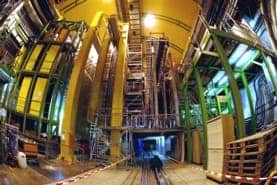It’s really awesome when the practice confirms the theory! Experiments at the Large Hadrdon Collider have revealed two never before seen particles – exotic types of baryons which were previously predicted by theoretical research. The new measurements serve to confirm and refine the existing theory of subatomic particles and help pave the way for the discovery of more particles predicted by the Standard Model.

CERN
The LHC is the world’s largest and most powerful particle collider, and actually the largest single machine in the world. Its goal is to test if theoretical predictions are correct and either confirm or infirm the Standard Model – a theory that classifies all the subatomic particles.
In this case, they discovered two types of baryons – Xib‘– and Xib*– (pronounced “zi-b-prime” and “zi-b-star”), February 10 in Physical Review Letters. (They posted a preprint of their paper in November on the arXiv server).
“These were two things that very much should have existed,” says Matthew Charles of Paris 6 University Pierre and Marie Curie, a co-author of the study. “Of course, you still have to check because every now and then you get a surprise.”
Baryons are composite subatomic particles made up of three quarks. The most familiar baryons are the protons and neutrons that make up most of the atoms, but some baryons are more exotic, depending on the quarks they are made from. Quarks are elementary particles (as opposed to composite particles, like baryons); there are six types of quarks, known as flavors: up, down, strange, charm, top, and bottom.
The two newfound baryons are higher-energy configurations, and their masses had been estimated on a theory called quantum chromodynamics (QCD), which describes the strong force – one of the four fundamental forces, responsible in part for nuclear attractions. The fact that the theoretical predictions fitted perfectly with what was observed in experiments is remarkable.
“This is a validation that the theoretical approach is the correct one and that we have the calculation under control,” says theorist Richard Woloshyn of the Canadian particle physics laboratory TRIUMF, who published a prediction of the Xib masses in 2009.


